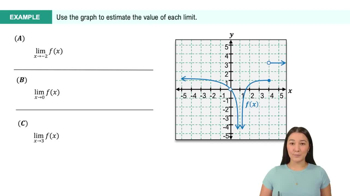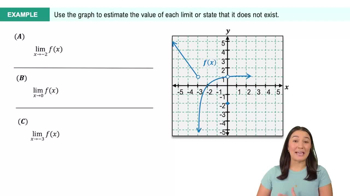Table of contents
- 0. Functions7h 52m
- Introduction to Functions16m
- Piecewise Functions10m
- Properties of Functions9m
- Common Functions1h 8m
- Transformations5m
- Combining Functions27m
- Exponent rules32m
- Exponential Functions28m
- Logarithmic Functions24m
- Properties of Logarithms34m
- Exponential & Logarithmic Equations35m
- Introduction to Trigonometric Functions38m
- Graphs of Trigonometric Functions44m
- Trigonometric Identities47m
- Inverse Trigonometric Functions48m
- 1. Limits and Continuity2h 2m
- 2. Intro to Derivatives1h 33m
- 3. Techniques of Differentiation3h 18m
- 4. Applications of Derivatives2h 38m
- 5. Graphical Applications of Derivatives6h 2m
- 6. Derivatives of Inverse, Exponential, & Logarithmic Functions2h 37m
- 7. Antiderivatives & Indefinite Integrals1h 26m
- 8. Definite Integrals4h 44m
- 9. Graphical Applications of Integrals2h 27m
- 10. Physics Applications of Integrals 2h 22m
1. Limits and Continuity
Introduction to Limits
Problem 2.7.48
Textbook Question
Use the precise definition of infinite limits to prove the following limits.
 Verified step by step guidance
Verified step by step guidance1
Step 1: Understand the definition of an infinite limit. The limit \( \lim_{x \to a} f(x) = \infty \) means that for every positive number \( M \), there exists a \( \delta > 0 \) such that if \( 0 < |x - a| < \delta \), then \( f(x) > M \).
Step 2: Consider the function \( f(x) = \frac{1}{x^4} - \sin(x) \). As \( x \to 0 \), \( \frac{1}{x^4} \to \infty \) and \( \sin(x) \to 0 \). Therefore, \( f(x) \to \infty \).
Step 3: For a given \( M > 0 \), we need to find \( \delta > 0 \) such that if \( 0 < |x| < \delta \), then \( \frac{1}{x^4} - \sin(x) > M \).
Step 4: Since \( \sin(x) \) is bounded, \( |\sin(x)| \leq |x| \). Therefore, \( \frac{1}{x^4} - \sin(x) \geq \frac{1}{x^4} - |x| \).
Step 5: Choose \( \delta \) small enough such that \( \frac{1}{x^4} - |x| > M \) for \( 0 < |x| < \delta \). This ensures that \( \frac{1}{x^4} - \sin(x) > M \), proving the limit is infinite.
 Verified video answer for a similar problem:
Verified video answer for a similar problem:This video solution was recommended by our tutors as helpful for the problem above
Video duration:
8mPlay a video:
Was this helpful?
Key Concepts
Here are the essential concepts you must grasp in order to answer the question correctly.
Infinite Limits
Infinite limits describe the behavior of a function as the input approaches a certain value, where the function's output grows without bound. Specifically, if the limit of a function as x approaches a value results in infinity, it indicates that the function increases indefinitely in that vicinity. Understanding infinite limits is crucial for analyzing functions that exhibit vertical asymptotes or unbounded growth.
Recommended video:

One-Sided Limits
Sine Function Behavior
The sine function, denoted as sin(x), oscillates between -1 and 1 for all real numbers x. As x approaches 0, sin(x) can be approximated by its Taylor series expansion, which shows that sin(x) behaves like x near zero. This property is essential for evaluating limits involving sin(x) and understanding how it interacts with other functions, particularly in the context of limits approaching zero.
Recommended video:

Graph of Sine and Cosine Function
Limit Definition and Evaluation
The precise definition of a limit involves the concept of approaching a value as closely as desired. To prove limits, one often uses algebraic manipulation, substitution, or the epsilon-delta definition. In this case, evaluating the limit requires analyzing the expression as x approaches 0, particularly focusing on the dominant term in the expression, which is crucial for determining the limit's behavior.
Recommended video:

Definition of the Definite Integral

 6:47m
6:47mWatch next
Master Finding Limits Numerically and Graphically with a bite sized video explanation from Callie
Start learning




